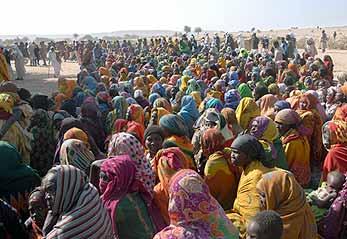Sudanese refugees report atrocities, says UNHCR in Chad

ABECHE, Chad, Jan 9, 2004 (UNHCR) — An emergency team from the UN refugee agency visiting the Chad-Sudan border has heard reports of killing and looting in western Sudan, and witnessed poor living conditions for thousands of Sudanese refugees in Chad.
On Thursday, the UNHCR team concluded a two-day mission to the north-eastern Birak area, where they visited the site of Djoran, 15 km from the Sudanese border. They found thousands of refugees (estimates range from 4,000 to 8,000) living in precarious conditions after fleeing western Sudan’s Darfur region.
At an altitude of 1,000 metres, the semi-arid Djoran site is hot in the day – there are few trees to provide protection from the sun – and just above freezing point at night. Strong winds blow sand throughout the day. The refugees live in makeshift shelters made from hay and branches collected nearby, but the fragile shelters are no bigger than 2-3 square metres each – tiny for a family with an average of five children. Some recently-arrived refugees have been sleeping rough in the bush as they have not had the time to build such shelters.
Most of the Djoran refugees arrived with little or nothing. Some of them have been here since last July and have survived thanks to food and water provided by the local Chadian population, especially from the nearby village of Bali. The Sudanese refugees and their Chadian hosts are from the same tribes, mainly the Djobal, Eranga and Zaghawa.
According to the refugee leader at Djoran – who himself arrived last August – 20 to 30 people are still arriving every day due to an increase in Arab militia attacks on Sudanese villages bordering Chad in the last 10 days.
UNHCR interviewed some of the recently-arrived refugees, who gave similar accounts of their flight: Militia men – known as the Janjaweed – usually attack the villages in the early morning. They shoot people in the streets before raiding the houses and stealing everything, including the cattle.
There have also been reports of rape and kidnapping of women and girls by the militia. These incidents could not be confirmed by humanitarian agencies – who are not allowed to work in the Darfur region – nor by the refugee women themselves due to communication problems and the fact that rape is a taboo subject.
A refugee from the Sudanese village of Garuma, 20 km from the border, told UNHCR that a week ago, 150 militia men wearing khaki clothes arrived on horses and camels in the village. He said all 2,000 people in the village fled – either to nearby villages where they have families or across the border to Chad. He took his pregnant wife and their five children to hide in the surrounding hills, where his wife gave birth the next day. He said the militia set the hill on fire, so he and his family escaped to another hill. He left his family there while he travelled on a donkey to Chad to check out the conditions before bringing them over.
Another refugee who arrived on Wednesday said she came there with her five children after the militia attacked Garuma and killed her father in his hut. Several other men were killed, she said, while others fled to the nearby hills with their livestock. The woman said her husband had left the village weeks ago to look for work in another part of Sudan.
Humanitarian agencies in eastern Chad are working closely to assist vulnerable refugees in the border sites where they have gathered spontaneously.
On Wednesday, UNHCR started distributing blankets provided by the UN Children’s Fund to children, pregnant women and the elderly in Djoran. It also gave out mats, jerry cans, kitchen sets and soap. Thousands of refugees also received oil and sorghum from the UN World Food Programme, which last week distributed food aid to refugees in Senette and Feguerra.
MSF-Belgique is providing medical assistance through its health centre in Birak. It also plans to dispatch a mobile team to the cantons of Bali and Guimeze to vaccinate the refugees. Some of them suffer from respiratory difficulties, while many children have conjunctivitis, an eye infection.
At the same time, UNHCR and local Chadian authorities are continuing their months-long search for inland sites to relocate refugees away from the insecure border. They are looking for locations at least 50 km from the border in hope of deterring frequent incursions by the Sudanese militia.
In this remote desert area, the biggest challenge is to identify sites with enough water resources for the refugees. Kouloungo, 60 km from the border, has been identified as a possible relocation site that can receive up to 20,000 refugees. A hydrologist from UNHCR’s partner agency, Gesellschaft für Technische Zusammenarbeit (GTZ), is scheduled to travel there on Saturday to evaluate the availability of water.
Similar water checks are going on at another possible site south of the city of Tine in the north-east. This is in addition to a site at Farchana, some 55 km from the border, which is nearing completion and should be ready to receive up to 9,000 refugees by mid-January.
UNHCR hopes to relocate the refugees from the border sites as soon as possible, before the start of the rainy season in mid-May renders the sand roads impassable for heavy trucks.
An estimated 95,000 Sudanese refugees have crossed into Chad since last April, with 30,000 arriving in the month of December alone due to an increase in militia attacks in Sudan’s Darfur region.
